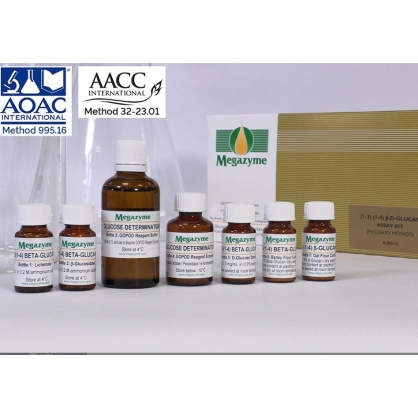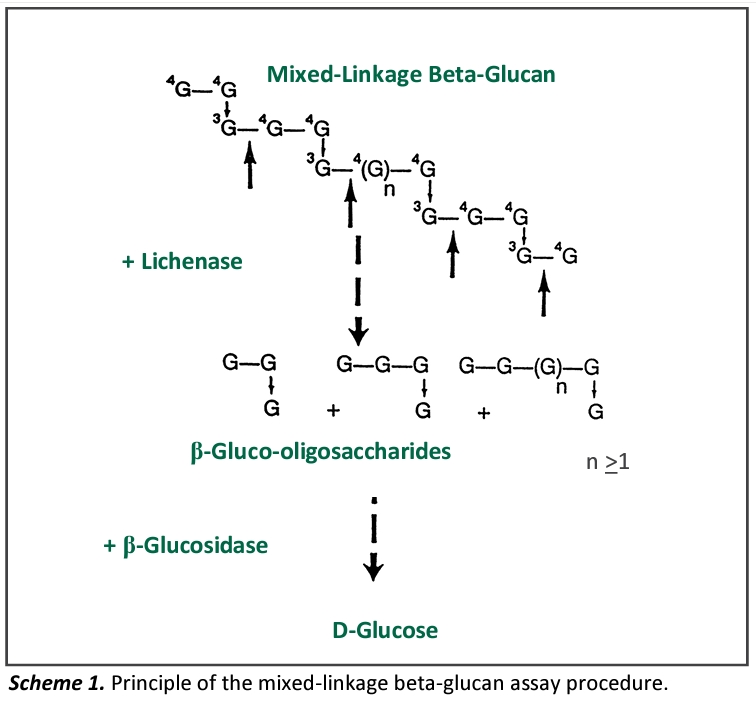- 背景資料
葡聚醣(Glucan)為D-葡萄糖單體藉由糖苷鍵連接的多醣,依據糖苷鍵鍵結方式的差異,可分成α-葡聚醣和β-葡聚醣
常見的α-葡聚醣:
1️⃣直鏈澱粉(amylose)➡️α-1,4糖苷鍵
2️⃣支鏈澱粉(amylopectin)➡️α-1,4糖苷鍵+α-1,6糖苷鍵
3️⃣肝醣(glycogen)➡️α-1,4糖苷鍵+α-1,6糖苷鍵
常見的β-葡聚醣:
1️⃣纖維素(cellulose)➡️β-1,4糖苷鍵➡️植物的細胞壁
2️⃣卡德蘭膠(Curdlan)➡️β-1,3糖苷鍵➡️細菌性胞外多醣體
大麥及燕麥含有豐富的膳食纖維,依據物理化學性質的不同,又可分成水溶性纖維和非水溶性纖維。
1️⃣水溶性纖維成分:混合鍵結 (1,3)(1,4)-β-D-葡聚醣組合成的高分子量線性長鏈多醣。根據過往的研究顯示,此物質具調節血脂及免疫調節之功能,且可減緩醣類吸收,避免餐後血糖過高...等功效
2️⃣非水溶性纖維成分:阿拉伯木聚醣(Arabinoxylans),為半纖維素的一種,其主鏈由木糖單糖以β-1,4鍵結方式所形成的異質性多醣體(heteropolysaccharides),支鏈為阿拉伯醣
各種麥類的β-葡聚醣約略含量
1️⃣大麥2.5%-11.3%
2️⃣燕麥2.2–7.8%
3️⃣黑麥 1.2–2.0%
4️⃣小麥 0.4–1.4% - ASSAY PROCEDURE FOR OAT AND BARLEY FLOUR AND FIBER SAMPLES - STREAMLINED METHOD
(AOAC Method 995.16, AACC Method 32-23 and ICC Standard Method No. 166).
This procedure is ideal for all dry samples particularly those containing high levels of β-glucan (e.g. processed oat bran products).
1. Mill barley, oats or fiber sample (approx. 50 g) to pass a 0.5 mm screen using a centrifugal mill.
2. Add flour sample (80-120 mg; weighed accurately) to a glass centrifuge tube (16 x 120 mm; 17 mL capacity). Tap the tube to ensure that all sample falls to the bottom of the tube.
3. Wet the sample with 0.2 mL of aqueous ethanol (50% v/v) to aid dispersion. Add 4.0 mL of 20 mM sodium phosphate buffer pH 6.5 and stir the contents on a vortex mixer.
4. On mixing, immediately place the tube in a boiling water bath and incubate for 60 sec. Vigorously stir the mixture on a vortex mixer, incubate at 100°C for a further 2 min and stir again.
5. Incubate the tube plus contents at 50°C and allow to equilibrate for 5 min.
6. Add 0.2 mL of solution 1 (diluted lichenase) and stir the tube contents. Seal the tube with parafilm and incubate for 1 h at 50°C, with regular vigorous stirring (i.e. 3-4 times) on a vortex mixer. Continuous stirring is recommended where possible.
7. Add 5.0 mL of 200 mM sodium acetate buffer pH 4.0 and vigorously mix the tube contents on a vortex mixer.
8. Allow the tube to equilibrate to room temperature (5 min) and centrifuge (1,000 g, 10 min). Carefully and accurately dispense aliquots (0.1 mL) into the bottom of three test tubes (12 mL capacity).
9. Add 0.1 mL of solution 2 (diluted β-glucosidase) to two of these tubes (the reaction). To the third (the reaction blank), add 0.1 mL of 50 mM acetate buffer pH 4.0. Incubate all tubes at 50°C for 10 min.
10. Add 3.0 mL GOPOD Reagent to each tube and incubate at 50°C for a further 20 min.
11. Remove the tubes from the water bath and measure the absorbance at 510 nm against reagent blank within 1 h.
- ASSAY PROCEDURE FOR COOKED, TOASTED OR EXTRUDED CEREAL PRODUCTS – STREAMLINED METHOD
(AOAC Method 995.16, AACC Method 3223 and ICC Standard Method No. 166).
In the analysis of β-glucan in cooked, toasted or extruded cereal products, the sample should be pre-extracted with aqueous ethanol to remove free sugars and to reduce the levels of fats and oils.
1. Mill food product (approx. 50 g) to pass a 0.5 mm screen using a centrifugal mill.
2. Add sample (~ 200 mg; weighed accurately) to a glass centrifuge tube (16 x 120 mm; 17 mL capacity). Tap the tube to ensure that all sample falls to the bottom of the tube.
3. Add 5.0 mL of aqueous ethanol (50% v/v) and incubate the tubes in a boiling water bath for 5 min. Mix the contents on a vortex stirrer and add a further 5.0 mL of 50% (v/v) aqueous ethanol. Mix.
4. Centrifuge the tubes for 10 min at 1,800 g (approx. 3,000 rpm). Discard the supernatant.
5. Resuspend the pellet in 5.0 mL of 50% (v/v) aqueous ethanol and stir on the vortex mixer. Add a further 5.0 mL of 50% aqueous ethanol. Stir on the vortex mixer, centrifuge and discard the supernatant (as in step 4).
6. Suspend the pellet in 4.0 mL of 20 mM sodium phosphate buffer pH 6.5 and incubate the tube at 50°C for 5 min.
7. Add 0.2 mL of solution 1 (diluted lichenase) and stir the tube contents. Seal the tube with parafilm and incubate for 1 h at 50°C, with regular vigorous stirring (i.e. 3-4 times) on a vortex mixer. Continuous stirring is recommended where possible.
8. Add 2.0 mL of 200 mM sodium acetate buffer pH 4.0 and vigorously mix the tube contents on a vortex mixer.
9. Proceed from Step 8 of method (A).
- ASSAY PROCEDURE FOR MILKSHAKE, YOGURT AND OTHER LIQUID SAMPLES (ALCOHOL PRECIPITATION).
1. Weigh accurately a glass centrifuge tube (16 x 120 mm; 17 mL capacity).
2. Add 3 mL of sample to the tube and heat in a boiling water bath for 5 min. Allow to cool to room temperature.
3. Add 3 mL of 95% aqueous ethanol to the tube and mix the contents on a vortex stirrer. Add a further 5.0 mL of 95% aqueous ethanol. Mix well on a vortex stirrer.
4. Centrifuge the tubes for 10 min at 1,800 g (approx. 3,000 rpm). Discard the supernatant.
5. Resuspend the pellet in 8.0 mL of 50% (v/v) aqueous ethanol and stir on the vortex mixer. Centrifuge and discard the supernatant (as in step 4).
6. Suspend the pellet in 20 mM sodium phosphate buffer pH 6.5 adjusting the volume to 4.0 mL (by weight), from the known weight of the empty tube. Incubate the tube at 50°C for 5 min.
7. Proceed from Step 6 of method (A).
商品特色
商品規格
- 商品規格(100個檢測反應)
Bottle 1:
Lichenase [specific, endo-(1-3)(1-4)-β-D-glucan 4- glucanohydrolase] suspension (1 mL).
Store at 4°C. See individual label for expiry date.
Bottle 2:
β-Glucosidase (1 mL) suspension.
Store at 4°C. See individual label for expiry date.
Bottle 3:
GOPOD Reagent Buffer. Buffer (50 mL, pH 7.4), p-hydroxybenzoic acid and sodium azide (0.09% w/v).
Store at 4°C. See individual label for expiry date.
Bottle 4:
GOPOD Reagent Enzymes. Glucose oxidase plus peroxidase and 4aminoantipyrine. Freeze-dried powder.
Store below -10°C. See individual label for expiry date.
Bottle 5:
D-Glucose standard solution (5 mL, 1.0 mg/mL) in 0.2% (w/v) benzoic acid.
Store sealed at room temperature. See individual label for expiry date.
Bottle 6:
Standardised barley flour control. β-Glucan content shown on vial label.
Store sealed at room temperature. See individual label for expiry date.
Bottle 7:
Standardised oat flour control. β-Glucan content shown on vial label.
Store sealed at room temperature. See individual label for expiry date.




